|
The Lusty Men
The 9th Air Force: the Destruction
of the Luftwaffe and Hunt for Nazi Air Technology
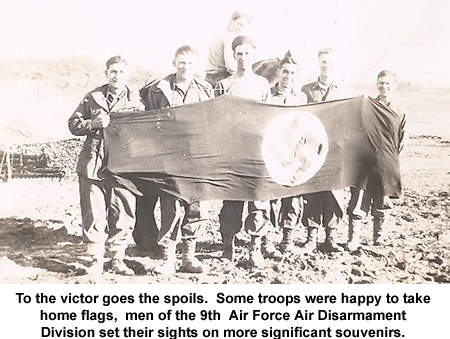 The
complete disassembly of the Luftwaffe and the quest for high
technology Nazi air weapons, a daunting task at the end of the war.
It fell to the 9th US Air Force with Headquarters in Kissingen.
Those senior commanders and staff personnel played a small role but
what their men did out in the field, at the air strips, factories
and depots had a lasting significance. Would a generation of
American fighter aircraft design stand on the shoulders of German
designers and technicians? The
complete disassembly of the Luftwaffe and the quest for high
technology Nazi air weapons, a daunting task at the end of the war.
It fell to the 9th US Air Force with Headquarters in Kissingen.
Those senior commanders and staff personnel played a small role but
what their men did out in the field, at the air strips, factories
and depots had a lasting significance. Would a generation of
American fighter aircraft design stand on the shoulders of German
designers and technicians?
On the one hand, flyable examples of the Messerschmitt 262 fighter,
with twin jet engines slung beneath the wings, were needed. The US
military jet program was in a stall and maybe the Germans had the
answers. At Kissingen, only a few airmen and officers at HQ read
the reports, after all it was mostly war end logistics and everyone wanted to go home, but those German jet aircraft were suddenly
streaking across the peaceful sky and they were heading west to
France, the coast and America.
wanted to go home, but those German jet aircraft were suddenly
streaking across the peaceful sky and they were heading west to
France, the coast and America.
On the other hand, the Allies of 1945 wanted to decimate the German
air war capability for all time. Someone had to do it and the
answer was quickly apparent. What remained after thousands of close
air support sorties and medium bomber attacks would be dealt with by
men in trucks and jeeps.
What a great interest the 9th Air Force hunters and gathers had with
the Luftwaffe and that specialized German air force equipment.
Experts in the Field
Most people have probably seen the recent movie, The Monument Men
that told the story of teams of American art experts drafted into
the military then working in the immediate post war period
throughout Europe locating, recovering and returning significant
artworks that had been looted by the Nazis. Their activities were
notable but not particularly unique.
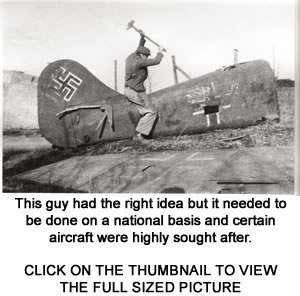
Within weeks of the Allied landings in Normandy, following close on
the heels of the combat units were teams, sections, squads of “
experts “ either by training or civilian experience, tasked with
turning - over - every - stone within their particular field of
interest.
Their charters ran through an amazing array of interests, some
groups searched for local banks and treasuries to seize and hold
Nazi money while others took into safe keeping local reserves of
French or Belgium Francs. Some teams looked for printing presses
that created postal stamps, other squads surveyed every meter of
railway line to organize repairs. One team cataloged the most
famous public clocks in town squares and two groups inspected every
automotive factory in Western Europe.
And then there were teams, pilots and supply men, drivers and
clerks, who wanted just one thing. Simply put, their goal was to
touch every German jet aircraft engine and flyable jet they could
find. Then put the plunder into boxes for shipment to Ohio. The
Air Disarmament Division had so many places to go and so much to see
and do. It was the days of searching and counting, disposal and
destruction and it was the days of German jets.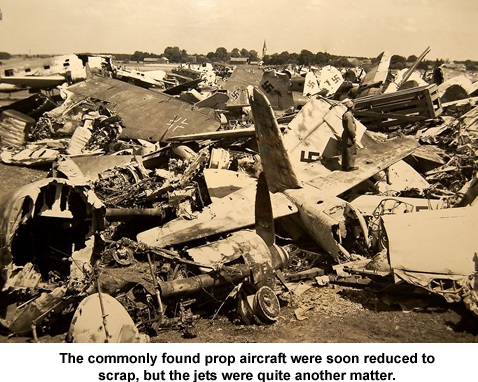
Wonder Weapons, the
Hunters and Gatherers
Initially, the 8th Air Force, responsible for the heavy bomber
fleets, was given the air disarmament mission and began planning and
staffing accordingly. In November 1944, the mission was handed off
to the 9th Air Force, probably because their air support mission
brought them closer to the targets at hand as the ground combat
units advanced and also, the 8th fully believed that its personnel
minus aircraft would be committed to the Pacific Theater. No need
for side mission distractions until Japan was defeated.
The air disarmament mission evolved into two clearly specified
tasks: find, identify and secure for shipment, German air weapons
and equipment that possessed technology or innovation that could be
rapidly exploited by American manufactures to improve the war effort
and defeat Germany and Japan. And then, any other air war materials
would be
consolidated, disposed of or destroyed as part of an overall
disarmament of Germany.
This mission encompassed everything from Luftwaffe belts, boots and
bedding to the highest levels of technology. Everything would be
looked at, counted and cataloged. On paper, the mission could
begin as early as February 1945 with US forces pressing into Germany
but the real job began in April as the war in Europe ended.
As expected, the design of the Air Disarmament Division, ADD,
evolved over time but when fully operational and at work, the unit
was divided into two Disarmament Wings, # 1 with HQ at Fulda and
#2 HQ at Kaufbeuren with each containing six or seven Disarmament
Squadrons. These were then further broken down into sections and at
the high personnel point, over 8000 Army airmen were assigned. The
Division was also tasked with collecting, evaluating and destroying
all German flak cannon and associated equipment. This required men,
trucks, tents and jeeps and a chain of command.
Staff planners looked at the least utilized units within the 9th and
hit upon the solution. Selected air defense artillery battalions
and other replacement air units would be converted to Air
Disarmament Groups reporting to the Services Command. Then, as
flight units turned in their aircraft, further selected personnel or
complete units would be transferred in. The goal was to get teams
of experts onto every German Air Force base, depot, warehouse or
facility as soon as practicable.
The initial search area was Bavaria and the American zone of control
but it rapidly expanded to the French and British zones where few
complaints were registered and then, as expected, Americans were
scooping gear into their trucks in the Russian zone amid angry
protests. It seems the Russians had their own plans for Nazi
technology. In a few key weeks, as diplomats and generals debated,
Americans looted as much technology from the Russian zone as they
could carry. It may not have been the most stuff but often it was
the key stuff.
So Many Places and So
Much to Do - the Gatherers
Beyond the sheer logistics of the operation, there were major
intelligence and operational concerns. Inspection target lists of
thousands of locations were generated by looking back at the bombing
target lists of the 8th and 9th Air Forces. Upwards of 60% of the
Luftwaffe technology targets had first appeared as bombing targets.
Further information came from the interviews of German technicians
and review of captured documents. Progress was slow at first but
the technology harvest began in earnest once the men of the ADD
learned how aircraft manufacturing and Luftwaffe equipment had been
dispersed and hidden in the final year of the war.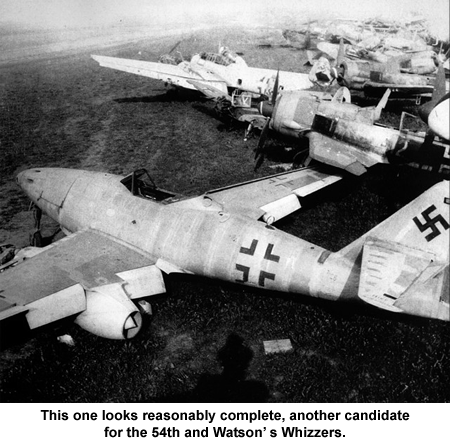
The
Air Technical Intelligence teams that physically inspected the sites
were rather small, a couple of jeeps and maybe a truck, ten or
twelve personnel on an initial visit A typical team would consist
of an OIC, a translator, and ten or so men trained in specific
technology areas such as radar and radios, target acquisition
equipment, rockets and bombs, specialized gear such as high altitude
equipment and weather instruments.
Depending upon what they found, larger teams would follow to
actually begin the sortation, boxing and shipment of items that
might have value. All of this was then either evacuated to the
United States through the 9th Air Force logistics chain or destroyed
on the spot. Some found items, such as medicines, certain clothing
and bedding were released to German control.
At the same time, Luftwaffe or civilian technical personnel were
interviewed and millions of documents were loaded into crates for
further study. The sheer volume led to quality control issues in
the gathering process.
On occasion, shipments would arrive in the United States with tons
of mixed equipment and no detailed notes as to origin or possible
use. Through late 1945 and 1946, record keeping and field notes
improved and this was appreciated by the men at the evaluation end
located primarily at Wright Patterson Army Air Force Base in Ohio.
All of these activities were reported to the Wing chains of command
to Bad Kissingen and HQ 9th USAF. From there, occasionally press
releases were issued to American newspapers detailing the various
finds of Nazi wonder weapons.
The disarmament of the Luftwaffe and search for exploitable
technology mission ended in mid 1946. The After Action Report of
the Air Disarmament Division stated in part:
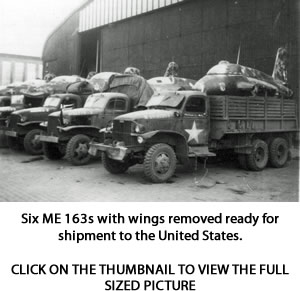
1894 tons of significant German Luftwaffe equipment had been shipped
to the United States for further testing and over 1 million tons of
equipment of all types related to the German Air Force had been
seized and destroyed.
9132 sites had been inspected in the American zone with an
additional 4000 sites visited in zones controlled by the British,
French and Russians.
The Lusty Men - the
Hunters
The search for the highest value targets of German aeronautical
technology was code named: Operation Lusty. A great name,
considering the chase aspect of the mission but it was coined as an
acronym from: LUftwaffe Secret Technology.
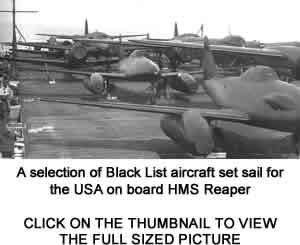
This program had its beginnings outside of the general air
disarmament plan. In fact, it was envisioned as an entity on to
itself and was staffed accordingly but soon on, if for no other
reason than tapping the expedient supply of men and equipment
available in the Air Disarmament Division, the Lusty mission was
folded into the 2nd Disarmament Wing and designated as the 54th Air
Disarmament Squadron. The unit was commanded by Colonel Harold E
Watson, who in turn worked for Colonel Donald L Putt - responsible
for the entire technology gathering mission in Germany.
Watson was a significant individual in the Army Air Force and had
spent much of the war stateside, helping manufacturers trouble shoot
and increase production of bomber engines. He had a firm grasp on
the technologies of the day and what would be the emerging
technologies of the post war period. He was also aware of the
problems the American aircraft companies were having in producing a
jet aircraft the Army could use and his technology assessment and
recovery team was tasked with the “ black list “ of Nazi systems and
specifically the German jets.
His team came to be known at Watson’s Whizzers and he hand picked
experienced fighter pilots to gather, then fly and evaluate the
German jets. The first priority was the ME 262.
ME 262
The twin engine ME 262 was the second operational jet fighter of the
war and over fourteen hundred were produced in underground factories
throughout central and southern Germany. It was good but not great
… but it was a jet fighter and the Allies had nothing like it. The
British Gloster Meteor got into the sky a bit earlier but had no
real impact on the war.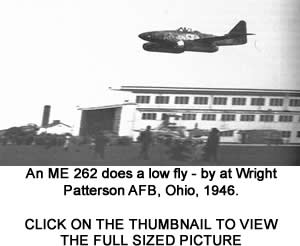
The aircraft featured an innovative modular construction that
allowed parts manufactured at various locations to be quickly
assembled into an operational fighter without the long traditional
assembly line and, with twin jet engines, in some missions, it did
have an air to air combat advantage. In straight line speed, it
could out run the Allied fighters and attack into the bomber groups.
But the ME also exhibited clear disadvantages that every American
fighter pilot knew. It was slow and unwieldy in take off and
landing, had a long and slow turn profile allowing piston driven
fighters to cut inside and gain advantage and the jet engines were
difficult to manufacture and not particularly reliable. In the
poker game of aerial dog fights, you could hedge your hand with a
bit of skill and luck.
Nevertheless, America wanted as many examples as they could find and
Watson was fast to the hunt. He scooped up several flyable examples
in southern Germany, tons of repair parts and fresh engines and
perhaps most importantly, dozens of both Luftwaffe and German
civilian technicians and pilots who saw a trip to the United States
as an attractive alternative to an uncertain fate in Germany.
Soon Watson and several American pilots were flying the jet aircraft
on their own, sometimes well in the sky and sometimes plowed into
the ground.
What the Hunters had
in the Bag and the Verdict
Ten operational ME 262s and thirty - one additional Black List or
other interesting German aircraft were loaded on the British
aircraft carrier HMS Reaper in mid Summer 1945 for transit to the
United States. In addition were several other disassembled and
crated aircraft.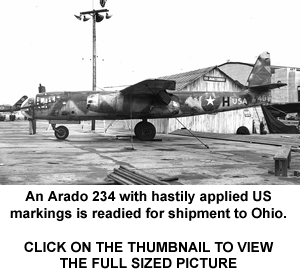
Watson chose to return to the US at the controls of an experimental
German four engine bomber while other whizzer pilots and team
members continued the search for, recovery and refurbishment of more
ME 262 examples. By late 1946, the missions of the Air Disarmament
Division and Watson’s 54th Squadron were completed; all they left
behind were the wrecks and piles of parts and pieces. They did not
get them all, the Russians had their share - but the Army Air Force
had more than enough.
Captured German jets in American markings flew for the next few
years in the skies over Ohio and Indiana as part of the testing and
evaluation program. In due course, the American F80 jet fighter
took to the air as America’s first production war jet; there may
have been some lessons learned from the ME 262 but it seems that
industry had solved many of the initial F80 issues and by 1949 the
ME 262 was becoming an obsolete curiosity. There really was no
resemblance or direct link between the ME 262 and the F 80.
But this is not to say that the search and recovery efforts were in
vain. Rather, Lusty showed American engineers and designers
possible routes to explore, exploit or dismiss. And when you win
the war, it is easy to believe that your design, testing and
evaluation processes are the best. Was there German blood in the F4
or F16 - that is very difficult to say.
How much was g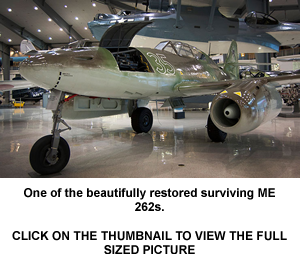 ained from the other tons of exported German air
technology is unknown. The Air Force spent about two years going
through their treasures and sharing what was learned with the
hundreds of American manufactures and engineers touring through
Wright Patterson. Beyond the ME, many of the other Black List
aircraft were finally disregarded as interesting but not significant
except for the twin engine Arado 234 bomber that was considered an
important technological innovation. ained from the other tons of exported German air
technology is unknown. The Air Force spent about two years going
through their treasures and sharing what was learned with the
hundreds of American manufactures and engineers touring through
Wright Patterson. Beyond the ME, many of the other Black List
aircraft were finally disregarded as interesting but not significant
except for the twin engine Arado 234 bomber that was considered an
important technological innovation.
Approximately fifty Black List German aircraft were returned to
America in the post war period and a few survive today on static
display at Wright Patterson or the Smithsonian Air Museum. Some
were traded to the British and French air force over the years and
many simply crashed in test flight or were considered no longer
critical to Air Force study and scrapped.
But the story does not quite end there. Just as we began with a
reference to a modern movie, we must end with a current zombie
movie. As the Air Force got rid of its German aircraft fleet, the
planes were cut up or shredded. But souvenir hunters and amateur
aircraft hunters will not be denied and the dead and destroyed never
sleep easily in their Mid West graves.
Nazi planes buried in an Indiana field
Coda
Of all of the Black List targets, by far the most significant finds
returned to the United States were the complete V2 rockets and many
tons of parts, plans, paper data, technicians and scientists. This
mission was largely taken outside of Operation Lusty and activities
of the Air Disarmament Division and then was executed as Operation
Paperclip, location and evacuation of Nazi V2 scientists and skilled
technicians and Operation Overcast and Special Operation V2:
physical recovery of rockets and components.
Beyond the fact that some of the German rocket scientists were
briefly housed in a Bad Kissingen hotel under Army supervision as
they waited for final disposition and movement to the United States,
there appears to be no link between the 9th Air Force, Kissingen and
the V2 post war exploitation process.
MG Harold E Watson bio
LTG Donald L Putt bio
Items and aircraft related to the high priority targets were handled
by special disarmament teams and named the Black List project. That
target list consisted of nine flight systems:
Click for outside links.
BUT, the story
does not end.
Air enthusiasts create modern ME-262s to take to the sky once again.
Reader Note:
There is no original research in this piece. It was assembled from
the various magazine articles that have been written on the hunt for
Nazi technology, the published After Action Report of the ADD and
the single best book on the subject: American Raiders by Wolfgang
W. E. Samuel.
April 2016 |